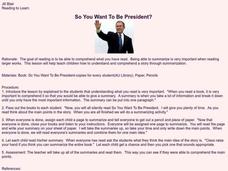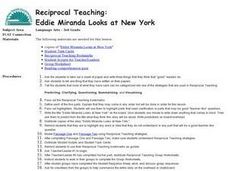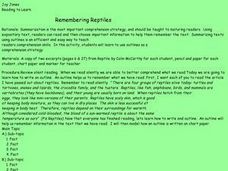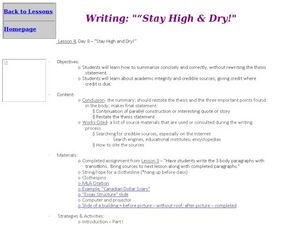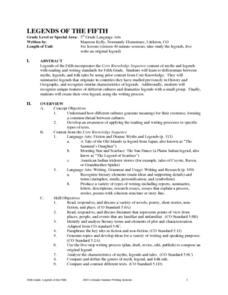Pennsylvania Department of Education
Stories? Information? What's the Difference?
Students listen to a power point presentation to distinguish between fiction and nonfiction text. In this what's the difference lesson, students identify fact from opinion within a text. Students listen critically and respond to text.
Curated OER
Reviewing Literary Elements
Students identify the elements of fiction, and work on compare and contrast skills.. In this comprehension instructional activity, students read different versions of Cinderella. Students use a Venn diagram to compare and contrast the...
Curated OER
So You Want to be President?
Students review the meaning of a summary and why they are important. They silently read the book, So You Want To Be President thinking about the main points in the story. When finished, each child summarizes a page from the book which...
Curated OER
Babushka's Doll
Third graders read the story Babushka's Doll and write a summary of the main events in the story. For this summaries lesson plan, 3rd graders discuss the country of Russia before they read.
Curated OER
Sum It Up
Students write summaries of books to exemplify comprehension of the stories. They create a story web to outline the important details of the story. In groups, students make story webs for separate chapters for the book. After the webs...
Curated OER
Reciprocal Teaching: Eddie Miranda Looks at New York
Third graders use the strategies in Reciprocal Teaching: predicting, clarifying, questioning, summarizing, and visualizing. They utilize these reading strategies when reading "Eddie Miranda Looks at New York."
Curated OER
Reciprocal Teaching: The Migrants
Fourth graders use techniques involved in Reciprocal Teaching: predicting, clarifying, questioning, summarizing, and visualizing. They use these reading strategies while reading "The Migrants."
Pennsylvania Department of Education
Using Literary Elements to Compare Fiction Texts
Students explore language arts by reading and reflecting on literary examples. In this fiction writing instructional activity, students read several different cultural versions of the story "Cinderella" and discuss their interaction with...
Curated OER
Outline of a Legend/Folk Tale
Students create outlines of folk tales and legends. They read a folk tale or legend in the target language. They complete an outline of the key events of the story including the main characters, plot, story elements and theme or moral.
Curated OER
Reading Response Log
In this reading response log learning exercise, 3rd graders summarize what they have read. Using the prompts, students complete 6 short answer questions about their story.
Curated OER
Remembering Reptiles
Students will learn to use outlines as a comprehension strategy. Summarization is the most important comprehension strategy, and should be taught to maturing readers. During this lesson learners use the story of a reptile to practice...
Curated OER
Outlining Essays (Grades 3-6)
Students brainstorm story idea in preparation of writing an expressive essay. They study how to outline essays to assist them in writing an expressive essay. Each students conclusion should summarize their main idea and restate their...
Curated OER
Writing: Stay High and Dry
Students write an effective conclusion for their essay. In this conclusion lesson plan students restate the thesis of their paper and summarize three important points. Students then write a final statement to wrap up their thoughts. ...
Curated OER
Legends of the Fifth
Fifth graders discover the difference between myths, legends, and folk tales. They summarize legends. They work together to dramatize legends and then create their own legend using the writing process. Handouts and worksheets are included.
Curated OER
Health Education: Germs
Second graders examine germs. In this personal health lesson plan, 2nd graders summarize the methods for preventing the spread of germs through food, water, air, and touch.
Curated OER
Successful Reading Strategies for ELL Students
Students improve their reading comprehension through predicting, connecting with text and summarizing. Students should have already read the book Seedfolks and made predictions based upon what they had seen from the cover and pictures...
Curated OER
Jalapeno Bagels
Pupils read the story Jalapeno Bagels and then write a summary about it. In this summary lesson plan, students retell the story as if someone else has not read the story.
Curated OER
Goldilocks and the Three Bears
Students comprehend written text by teaching them how to think about the events in a story as they read. They make storyboards of their own. They need to make sure they put the events on the storyboard in the proper order.
Curated OER
Recreating Storyline
Seventh graders engage in a lesson that focuses on the sequence of a story and they discover its importance in the context of improving reading comprehension. Students analyze the plot of a story and reconstruct it into the right order.
Curated OER
Sequence Of Events
Third graders are introduced to the concept of sequence of events. They work in groups to properly sequence The Three Little Pigs, then work individually to write their own stories about their individuality.
Curated OER
Superman: Modern Mythology
Students discuss what characteritics belong to a hero. They examine different mythological stories and identify the theme of each. They compare and contrast the origin of Superman to the mythological stories and report their findings to...
Curated OER
Tell Me; I'll Listen
Students complete activities about the importance of listening in order to show respect. In this listening lesson, students read Angel Child, Dragon Child and discuss the role of listening. Students practice listening in pairs by telling...
Curated OER
Gingerbread Baby
Students explore gingerbread stories. In this poetry lesson, students read the folk tale "The Gingerbread Man" as well as Gingerbread Baby by Jan Brett and identify rhyming words. Students also make art projects, dramatize the stories,...
Curated OER
Problem and Solution Lesson
Students explore problems and solutions in literature. In this literature lesson, students identify problems and solutions in short guided and independent reading samples. Students also discuss characterization techniques used to develop...




